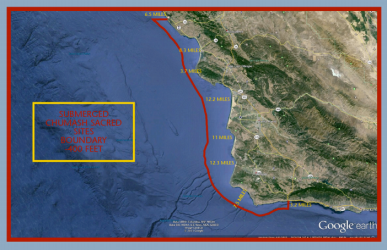Chumash Heritage National Marine Sanctuary
Purpose and Area
 The proposed Chumash Heritage National Marine Sanctuary is dedicated to the nurturing of relationships to Nature and the Ocean in the deepest ways possible. The Chumash understanding and culture-based respect for Nature comes from their long and profound relationships with coastal marine ecosystems.
The proposed Chumash Heritage National Marine Sanctuary is dedicated to the nurturing of relationships to Nature and the Ocean in the deepest ways possible. The Chumash understanding and culture-based respect for Nature comes from their long and profound relationships with coastal marine ecosystems.
The proposed Sanctuary embodies internationally and nationally significant oceanographic features, habitat and sacred Chumash onshore and submerged sites, some as far as13 miles offshore. Codependent onshore resources include the high coastal dunes, wetlands and Chumash Sacred sites continuously occupied for 9,000 or more years.
Other significant features include: the major offshore Santa Lucia Bank with benthic communities of world-wide significance where13 species of whales and dolphins gather and feed; three major upwellings, one of which is persistent, bringing up nutrient-rich water to feed marine life that also enhances the ecosystems of the two adjacent Sanctuaries; a 3,000 meter deep five-fingered submarine canyon through which the west coast’s only persistent upwelling flows; cetacean gathering areas and migration lanes.
Additionally, there are a significant percentage of the California sea otter population; thriving kelp forests; rocky intertidal regions with world-class fish diversity and densities; large numbers of pinnipeds including pupping areas and a significant percentage of harbor seals; spawning areas and rookeries; nurseries; three estuaries; high coastal dunes; magnificent views and vistas; and, the splendid waters of Morro, Estero and San Luis Bays.
This area of proposed protection, between the Channel Islands National Marine Sanctuary and the Monterey Bay National Marine Sanctuary and out to the western slope of the Santa Lucia Bank, warrants protection under the National Marine Sanctuary Program for the purpose of embracing the Chumash concept of “thrivability” wherein a deep understanding of this unique and precious marine environment is embodied within its local human inhabitants. The Marine Sanctuary will not regulate harbors, recreational or commercial fishing.
Chumash Sacred Sites within the California Central Coast
 The Sanctuary will protect now submerged Chumash Sacred sites ranging from villages to solstice alignments 6 to 13 miles offshore. Chumash records suggest occupation of the central coast area for 20,000 years with two recorded dates of:
The Sanctuary will protect now submerged Chumash Sacred sites ranging from villages to solstice alignments 6 to 13 miles offshore. Chumash records suggest occupation of the central coast area for 20,000 years with two recorded dates of:
* 18,000 years at Point Conception, an extremely important Chumash Sacred Place
* 14,500 years on the Channel Islands
North of Point Conception, Jalama is a Sacred Chumash village site. Other significant Chumash sites associated with the ocean ecology are found along the adjacent coastal terrain north to Point Sal including two 10,000 year-old sites within Vandenberg AFB.
Onshore San Luis Bay are four major Chumash Sacred sites – three known to have been occupied for 9,000 years:
* The site for which the City of Pismo Beach is named
* The site where the Chumash people return to renew the Traditional Ritual Ceremony Cycle
* The old Chumash Capital in the area of Avila Beach, now partially covered by sea level rise
* The Chumash Sacred site at Diablo Cove along the coastline of the Pecho Coast
Continuing north are the Chumash Village Sacred site in Los Osos, hundreds of Chumash Sacred sites ringing Morro Bay, the Chumash village Sacred site of Cayucos (continuously occupied for 8,000 years), other large sites found in the area to a mile north of Pt. Estero, and two Chumash village Sacred sites in Cambria (continuously occupied for 10,000 years).
Request for Designation
To ensure the protection of these Chumash Sacred Sites as part of the ecological, historical, cultural, educational and aesthetic resources of this area, we wish to facilitate the local, proactive approach to ocean protection that a National Marine Sanctuary brings to the management of significant marine resources. Therefore we nominate these waters for designation as a National Marine Sanctuary.
